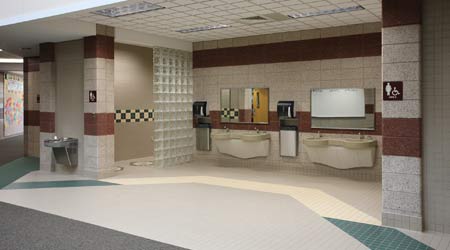 In elementary schools, sinks located in hallway alcoves provide greater visibility of what students are doing and help them move more quickly in and out of the restroom. Photo courtesy of Fanning Howey
In elementary schools, sinks located in hallway alcoves provide greater visibility of what students are doing and help them move more quickly in and out of the restroom. Photo courtesy of Fanning HoweyEvaluating Hand-Drying, Interiors Solutions in High-Traffic Restrooms
Facility managers must weight the age-old debate: Hand-dryers vs. towels. As well, make sure ceilings, floors, and walls are aesthetically pleasing and durable.
Preferences vary when it comes to the type of hand drying solutions installed in restrooms. If dryers are installed in schools, most choose battery-operated ones, as wired models tend to be more expensive, Schipp says.
One concern with hand dryers is that the users’ hands are wet as they approach the dryers. Over time, the drips can degrade the surface below the dryers, Schipp says. To alleviate this issue, a water-resistant material typically covers that section of the wall.
In elementary schools, paper towels, sometimes in conjunction with hand dryers, are more common, Wroble says. The towels can work more quickly than dryers, so the kids return to class sooner. In addition, the noise generated by hand dryers can scare some younger students. The downside, of course, is that towels tend to get messy and require continual refilling.
Ceilings, floors, and walls
When choosing ceiling materials for middle and high schools, the potential for students to use the ceiling to hide contraband becomes a concern. While suspended ceiling grids offer easy access to plumbing and HVAC equipment, they also can become hiding places for alcohol, drugs or other contraband, Wroble says. For that reason, drywall sometimes is used.
If a grid is chosen, Schipp opts for painted aluminum over painted steel, as it’s less vulnerable to rust. He’ll typically combine it with a durable, hard ceiling panel with a mylar finish that allows for easy cleaning. “You can remove it, scrub it, and put it right back up,” he says.
For restroom floors, a poured epoxy product that allows for a continuous, seamless surface is common, Wroble says. The colors can be customized and it’s durable and easily cleaned. Granules can be mixed into the epoxy to give it texture and provide a better grip.
In middle and high schools, structural glazed facing tile is one option for walls. The finish is baked in to the product, so it won’t lose its luster or color when cleaned, Wroble says. Similarly, finishes that incorporate some texture or flecks of color are better at hiding damage or dirt than purely solid colors, he adds.
That said, painted concrete block is common for restroom walls in schools, Wroble notes. Cost is a major reason. Drywall and other materials requires building a wall and then adding another, cladding it with another material. “Essentially, you’re building it twice,” he says. An epoxy paint looks nice and is more durable than latex.
In airport restrooms, cleanability and durability also are key attributes of wall and floor surfaces. For that reason, floor tiles that measure three-by-nine feet are popular. Their large size reduces the number of grout joints; grout tends to attract dirt, Sweet says.
Even as designers focus on the durability, strength and other practical aspects of the materials they choose, they’re also trying to create a hospitable environment, Smith says. “We want to raise the aesthetic but provide durability.”
Karen Kroll, a contributing editor for Building Operating Management, has written extensively about real estate and facility issues.
Email comments and questions to edward.sullivan@tradepress.com.
Related Topics:















